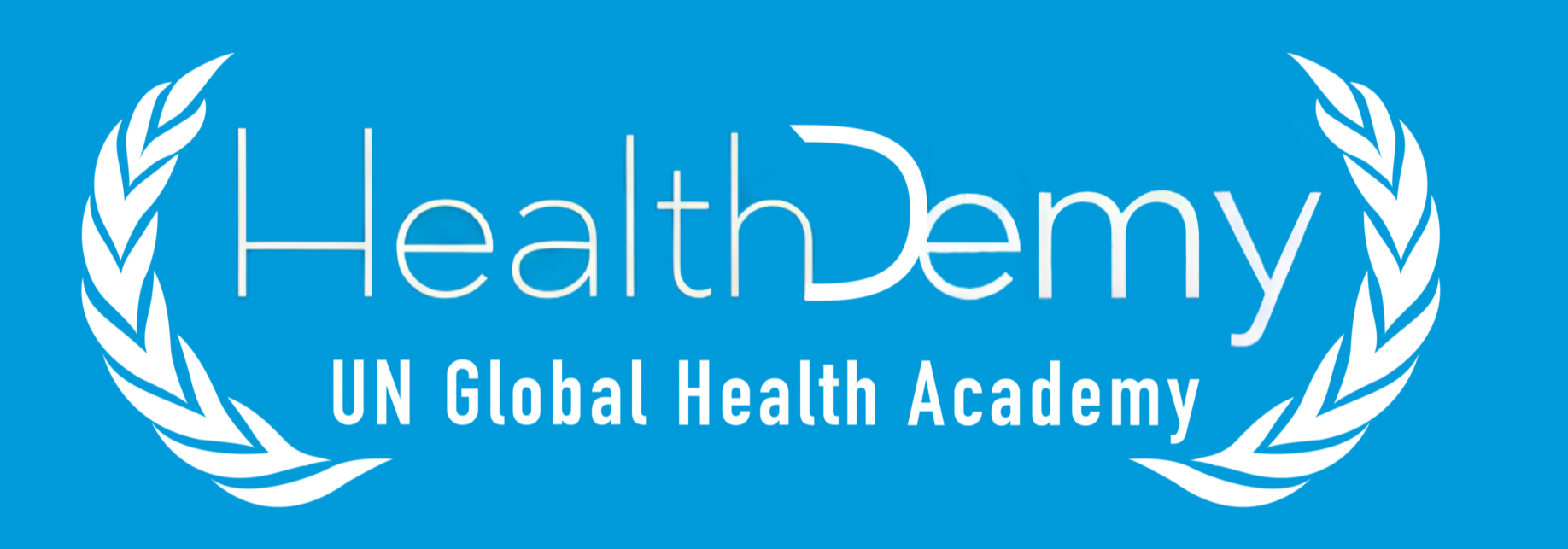Competency-Based Learning: What’s in It for You?
Feb 13
/
Divya Menon
As a curriculum or learning designer, few things are as heartbreaking as spending months crafting a course, only to witness low engagement, high dropout rates, and lacklustre response from your target learners. Unfortunately, disengagement is a widespread issue.
Consider these statistics:
- Around 90% of online learners disengage with MOOCs (Reich, J., & Ruipérez-Valiente, J. A., 2019; Moore, R. L., & Blackmon, S. J., 2022).
- Approximately 20-30% of learners drop out of face-to-face courses (Rothkrantz, L., 2017).
- At least 39% of US university students do not complete their degree (Hanson, M., 2024).
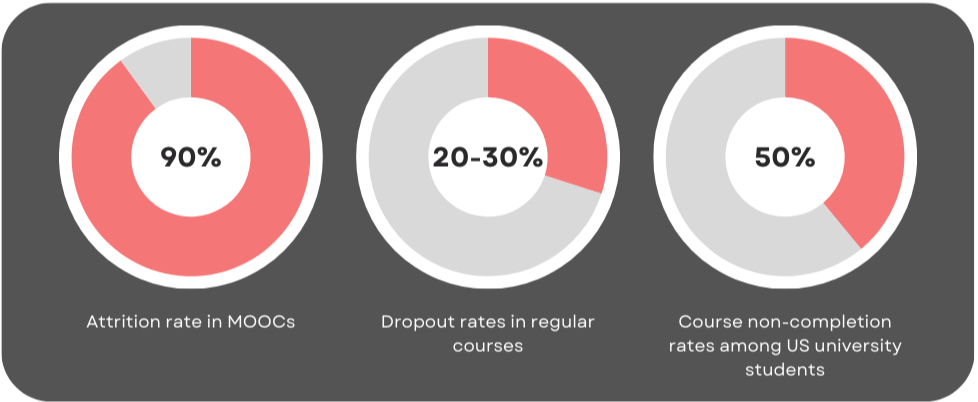
What Makes Learners Drop Out?
Learners mostly lose interest in a learning experience when it fails to cater to their individual needs (MIT News, 2017). According to UNITAR’s evaluation of its 2023 learning programmes, lack of motivation or interest is one of the top six reasons for course non-completion (UNITAR, 2023). On the other hand, critical factors that motivate learners to enrol in and complete a course (UNITAR, 2024; Cilliers, L., Twinomurinzi, H., & Murire, O., 2023) include:
- Interest in the topic;
- Desire to acquire knowledge;
- Personal commitment to growth; and
- Perceived usefulness for career advancement.
To meet its strategic goals aligned with Sustainable Development Goal (SDG) 4 on Quality Education and SDG 3 on Good Health, UNITAR’s Division on NCD, Digital Health, and Capacity Building delivers competency-based capacity-building programmes and learning opportunities. These programmes offer learners the opportunity to develop targeted competencies while equipping them with the required knowledge and skills in desired domains using a competency-based approach.
Understanding Competency-Based Learning (CBL)
Competency-based learning is defined as “a student-centred, self-directed, and experiential approach, facilitating skill and competency development, including higher order thinking skills and problem-solving skills” (Sistermans IJ., 2020, para 22). CBL is a framework for learning and assessment that empowers learners with targeted competencies based on their learning requirements and supports their learning journey through demonstrated mastery of specific skills and knowledge (Oroszi, T., 2020).
Unlike linear educational models that focus on seat time and assessment scores, CBL prioritizes:
- Demonstrated mastery of skills and knowledge;
- Real-world application of learning;
- Flexible, personalized learning pathways; and
- Competency-aligned assessments that measure performance in practical contexts.
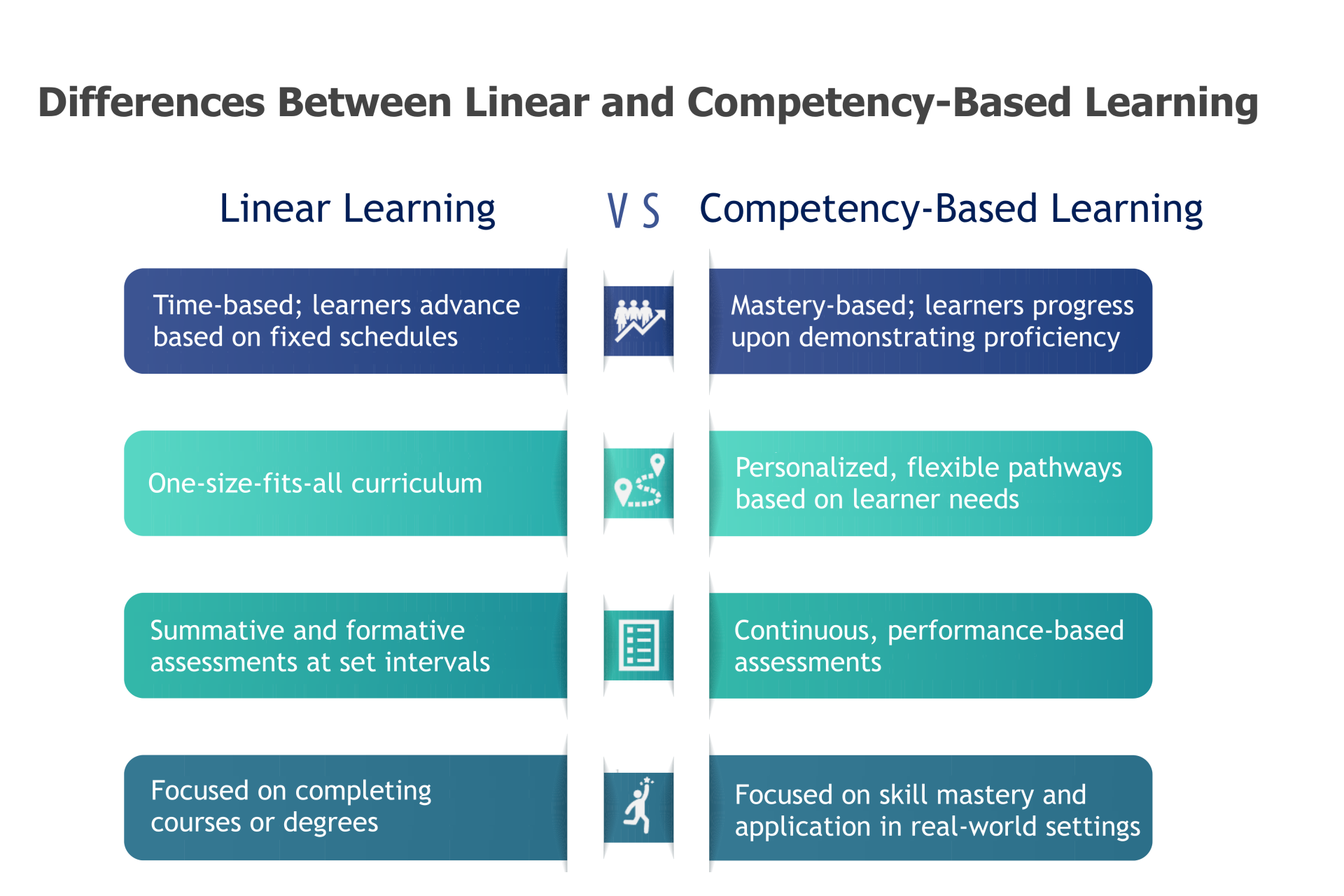
Key Concepts of CBL
CBL is built on fundamental principles that ensure learners develop the necessary skills efficiently and effectively. Understanding these key concepts helps in designing impactful learning experiences (Henri, M., Johnson, M. D., & Nepal, B., 2017).
- Mastery-based progression: Learners must demonstrate proficiency in specific knowledge and skills to progress (Levine, E. & Patrick, S., 2019).
- Constructive alignment: The learning experiences are designed to ensure alignment between identified learning goals, predetermined knowledge and skills, targeted proficiency level, and expected performance in the real world.
- Personalized, flexible learning pathways: Learners pursue personalized, flexible learning pathways that take an evolving approach to lifelong learning needs based on their current level, future aspirations, and unique learning requirements (Bayly-Castaneda, K., Ramirez-Montoya, M., & Morita-Alexander, A., 2024).
- Self-directed learning: Learners feel a sense of agency to manage their learning journey and visibility into the direct applicability of their learning to the real world.
Why Choose the CBL Approach?
CBL is not just a trend—it’s a proven approach rooted in research.
Emerging from behaviourism and systems theory, CBL gained traction in higher education in the 1960s, notably through the Accreditation Council for Graduate Medical Education (Nodine, T., 2016). By the late 90s, medical education globally embraced competency frameworks, revolutionizing training methods.
Today, CBL is widely adopted in both adult learning and K-12 education, offering a structured yet flexible approach that mirrors real-world skill development.
Today, CBL is widely adopted in both adult learning and K-12 education, offering a structured yet flexible approach that mirrors real-world skill development.
The Benefits of CBL
CBL benefits learners, organizations, and learning designers alike:
- Personalized approach – Adapts to each learner’s pace and needs (Amzil, I., Aammou, S., & Zakaria, T., 2023).
- Evidence-based learning – Ensures learning is rooted in research and real-world application.
- SMART learning objectives – Sets explicit, transparent, and measurable learning objectives.
- Authentic assessments – Evaluates performance based on assessment practices that offer multiple opportunities to demonstrate mastery rather than a one-time pass/fail approach (Alt, D., Naamati-Schneider, L., & Weishut, D. J., 2023).
- Institutional and organizational alignment – Aligns training goals with workforce needs.
- Efficiency in learning design – Enhances impact by focusing on relevant, high-priority skills.
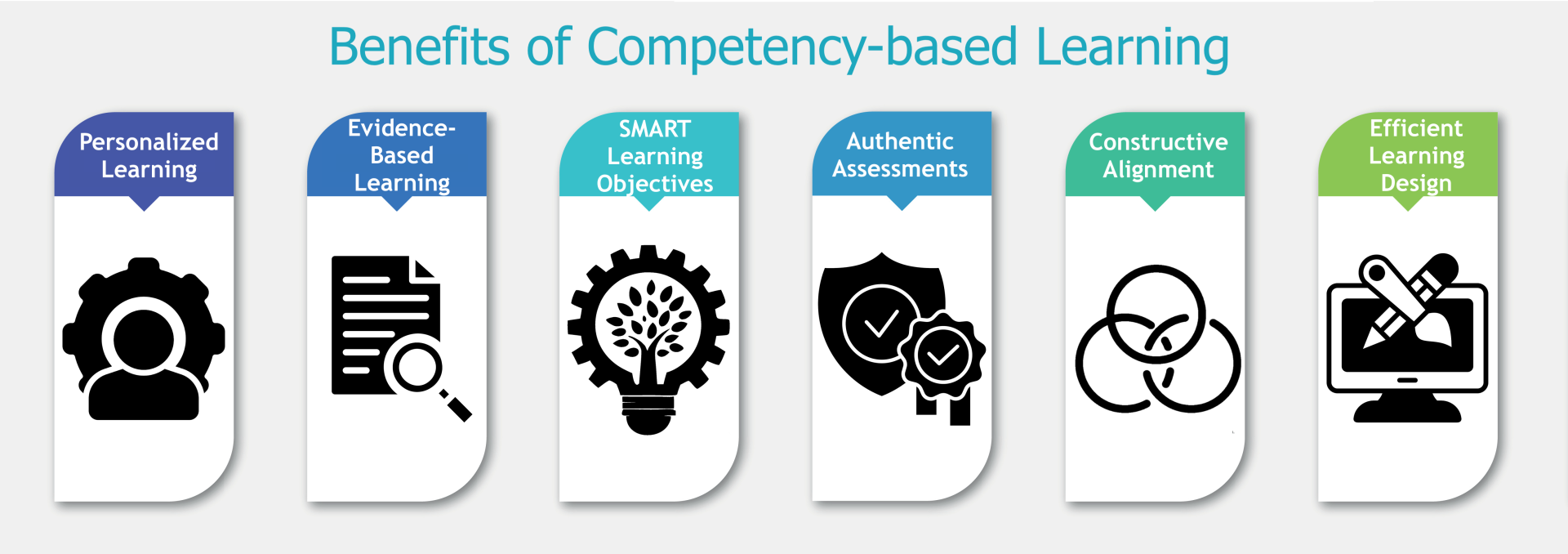
Is CBL the Right Approach for You and Your Learners?
Traditional learning approaches may be more suited to learning contexts with limited resources, a fixed curriculum, and time constraints (Sharp, K., Teli, S., Mahajan, H., & Sonawane, R., 2022). However, the easiest way to determine if competency-based learning is the right approach is to conduct a thorough needs assessment to determine the business need or problem you are trying to solve and whether training is indeed the optimum solution to address this challenge.
How to Design a CBL Course
Implementing a competency-based approach requires careful planning and execution. Once you have secured stakeholder buy-in for the CBL approach, follow these key steps to design a CBL course that aligns with learner needs and organizational goals.
- Conduct a competency gap analysis – Use insights from the needs assessment to conduct a competency gap analysis and identify gaps between current and desired knowledge and skills.
- Map knowledge and skills to competencies – Map the targeted knowledge and skill levels to specific competencies for each role from the chosen competency framework.
- Define SMART learning objectives – Set Specific, Measurable, Achievable, Relevant, and Time-bound objectives aligned with each competency.
- Develop evidence-based assessments – Establish standards or a rubric to measure each competency and design an assessment and learning strategy around it to measure real-world application.
- Select appropriate delivery methods – Select the appropriate medium of learning, delivery format, technologies, and tools that support learning in the specific context.
- Design engaging learning activities – Create and align learning content and practice activities tailored to address identified competency gaps and learning objectives.
- Facilitate flexible learning paths – Facilitate flexible learning paths that allow learners to progress based on demonstrated mastery.
- Integrate continuous feedback – Integrate continuous feedback to guide learners towards targeted competencies.
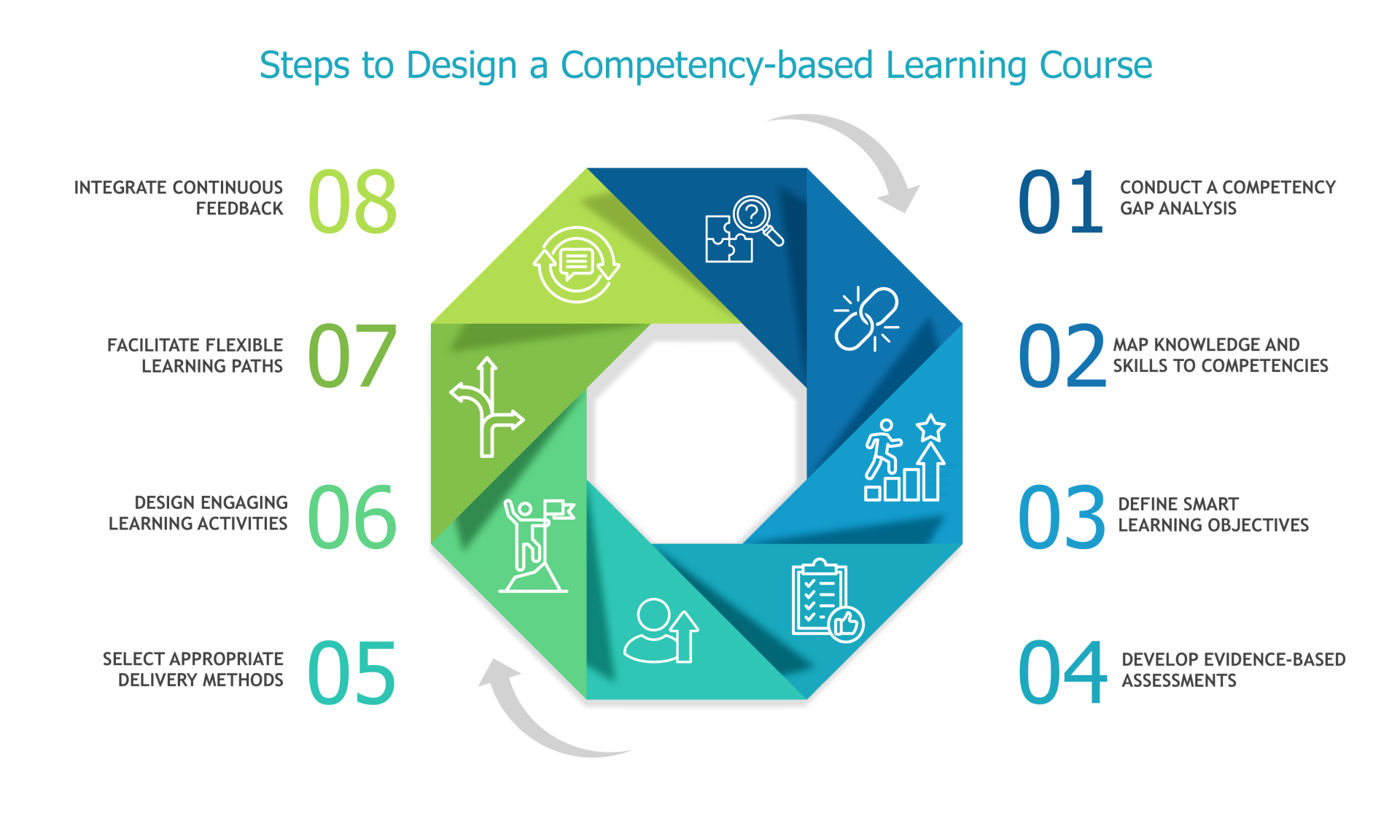
Conclusion: The Future of Learning is Competency-Based
Competency-based learning is reshaping education and professional training by making learning more personalized, goal-driven, and impactful. CBL empowers learners to thrive in dynamic, skill-driven environments by focusing on real-world competencies rather than passive knowledge accumulation.
Want to design competency-based courses that drive real impact? Sign up for UNITAR’s course on Competency-Based Learning Design today and equip yourself with the tools to transform learning experiences.
Register now: https://forms.gle/zqoY7FRfMuUfhg1V8
Want to design competency-based courses that drive real impact? Sign up for UNITAR’s course on Competency-Based Learning Design today and equip yourself with the tools to transform learning experiences.
Register now: https://forms.gle/zqoY7FRfMuUfhg1V8
References
- Alt, D., Naamati-Schneider, L., & Weishut, D. J. (2023). Competency-based learning and formative assessment feedback as precursors of college students’ soft skills acquisition. Studies in Higher Education, 48(12), 1901–1917. https://doi.org/10.1080/03075079.2023.2217203
- Amzil, I., Aammou, S., & Zakaria, T. (2023). ENHANCE STUDENTS’ LEARNING BY PROVIDING PERSONALIZED STUDY PATHWAYS. Conhecimento & Diversidade, 15(39), 83–93. https://doi.org/10.18316/rcd.v15i39.11130
- Bayly-Castaneda, K., Ramirez-Montoya, M., & Morita-Alexander, A. (2024). Crafting personalized learning paths with AI for lifelong learning: a systematic literature review. Frontiers in Education, 9. https://doi.org/10.3389/feduc.2024.1424386
- Cilliers, L., Twinomurinzi, H., & Murire, O. (2023). Motivational Factors that Influence the Course Completion Rate of Massive Open Online Courses in South Africa. International Journal of Learning Teaching and Educational Research, 22(6), 195–211. https://doi.org/10.26803/ijlter.22.6.12
- Hanson, M. (2024). College Dropout Rate [2023]: by Year + Demographics. Education Data Initiative. https://educationdata.org/college-dropout-rates
- Henri, M., Johnson, M. D., & Nepal, B. (2017). A review of Competency‐Based Learning: Tools, assessments, and recommendations. Journal of Engineering Education, 106(4), 607–638. https://doi.org/10.1002/jee.20180
- Independent evaluation of the UNITAR’s joint master’s degrees and other postgraduate non-degree programmes. (2024). UNITAR. https://unitar.org/results-evidence-learning/evaluation/independent-evaluation-unitars-joint-masters-degrees-and-other-postgraduate-non-degree-programmes
- Key Performance Indicators. (2023). UNITAR. https://unitar.org/results-evidence-learning/key-performance-indicators
- Levine, E. & Patrick, S. (2019). What is competency-based education? An updated definition. Vienna, VA: Aurora Institute. Licensed under a Creative Commons Attribution 4.0 International license. https://aurora-institute.org/wp-content/uploads/what-is-competency-based-education-an-updated-definition-web.pdf
- Moore, R. L., & Blackmon, S. J. (2022). From the learner’s perspective: A systematic review of MOOC learner experiences (2008–2021). Computers & Education, 190, 104596. https://doi.org/10.1016/j.compedu.2022.104596
- Nodine, T. (2016). How did we get here? A brief history of competency‐based higher education in the United States. The Journal of Competency-Based Education, 1(1), 5–11. https://doi.org/10.1002/cbe2.1004
- Oroszi, T. (2020). Competency-Based education. Creative Education, 11(11), 2467–2476. https://doi.org/10.4236/ce.2020.1111181
- Reich, J., & Ruipérez-Valiente, J. A. (2019). The MOOC pivot. Science, 363(6423), 130–131. https://doi.org/10.1126/science.aav7958
- Rothkrantz, L. (2017). Dropout rates of regular courses and MOOCs. In Communications in computer and information science(pp. 25–46). https://doi.org/10.1007/978-3-319-63184-4_3
- Sharp, K., Teli, S., Mahajan, H., & Sonawane, R. (2022). Comparative study between academic performances of traditional versus competency-based medical education M.B.B.S. curriculum students in Pharmacology. National Journal of Physiology Pharmacy and Pharmacology, 13(5), 1. https://doi.org/10.5455/njppp.2023.13.09461202202102022
- Sistermans IJ. (2020). Integrating competency-based education with a case-based or problem-based learning approach in online health sciences. Asia Pacific Educ. Rev. 2020;21(4):683–96. Epub 2020 Nov 18. PMCID: PMC7672406. doi: 10.1007/s12564-020-09658-6.
- Study of MOOCs offers insights into online learner engagement and behavior. (2017, January 12). MIT News | Massachusetts Institute of Technology. https://news.mit.edu/2017/mooc-study-offers-insights-into-online-learner-engagement-behavior-0112
Copyright: © 2024 The Defeat-NCD Partnership. All rights reserved.
